Remote Intelligence and Management Skills for Geographically Separated Teams
VerifiedAdded on 2024/05/14
|15
|3123
|217
AI Summary
Explore the critical management functions and skills needed for managing geographically separated teams. Understand the rise of telecommuting, remote intelligence, and its impact on Western workforces. Delve into the ethics, benefits, and challenges of remote intelligence.
Contribute Materials
Your contribution can guide someone’s learning journey. Share your
documents today.
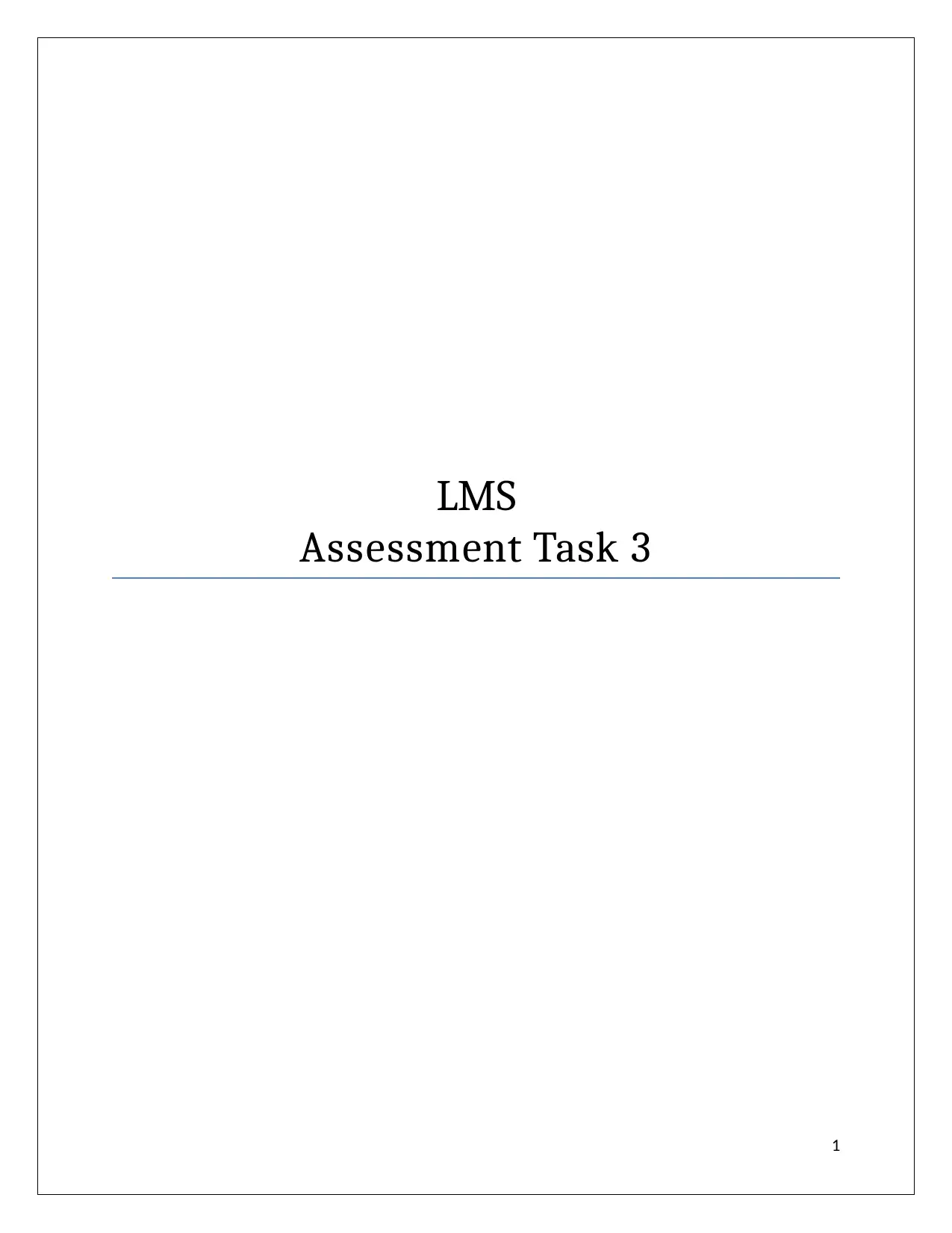
LMS
Assessment Task 3
1
Assessment Task 3
1
Secure Best Marks with AI Grader
Need help grading? Try our AI Grader for instant feedback on your assignments.
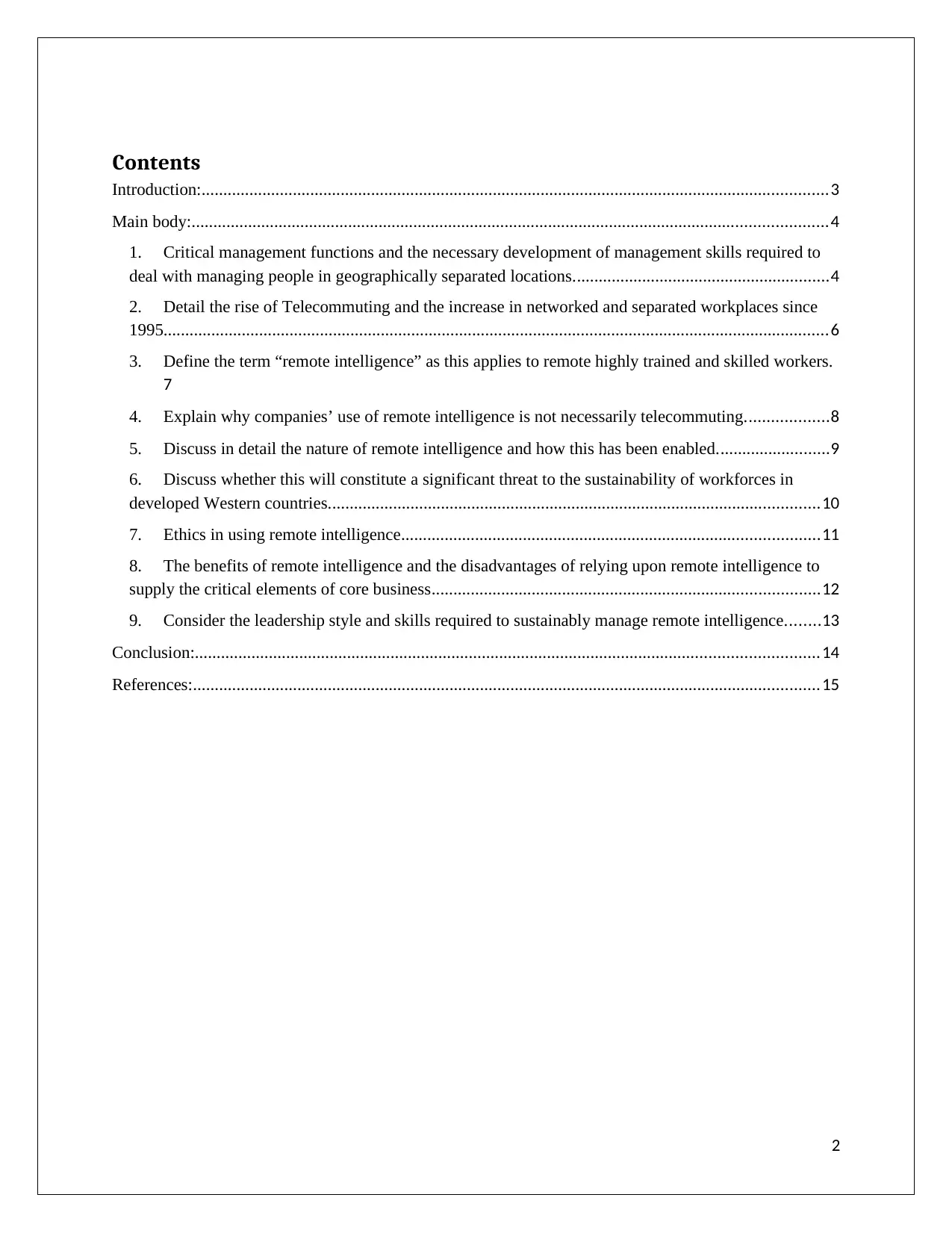
Contents
Introduction:................................................................................................................................................3
Main body:..................................................................................................................................................4
1. Critical management functions and the necessary development of management skills required to
deal with managing people in geographically separated locations...........................................................4
2. Detail the rise of Telecommuting and the increase in networked and separated workplaces since
1995.........................................................................................................................................................6
3. Define the term “remote intelligence” as this applies to remote highly trained and skilled workers.
7
4. Explain why companies’ use of remote intelligence is not necessarily telecommuting...................8
5. Discuss in detail the nature of remote intelligence and how this has been enabled..........................9
6. Discuss whether this will constitute a significant threat to the sustainability of workforces in
developed Western countries.................................................................................................................10
7. Ethics in using remote intelligence................................................................................................11
8. The benefits of remote intelligence and the disadvantages of relying upon remote intelligence to
supply the critical elements of core business.........................................................................................12
9. Consider the leadership style and skills required to sustainably manage remote intelligence........13
Conclusion:...............................................................................................................................................14
References:................................................................................................................................................15
2
Introduction:................................................................................................................................................3
Main body:..................................................................................................................................................4
1. Critical management functions and the necessary development of management skills required to
deal with managing people in geographically separated locations...........................................................4
2. Detail the rise of Telecommuting and the increase in networked and separated workplaces since
1995.........................................................................................................................................................6
3. Define the term “remote intelligence” as this applies to remote highly trained and skilled workers.
7
4. Explain why companies’ use of remote intelligence is not necessarily telecommuting...................8
5. Discuss in detail the nature of remote intelligence and how this has been enabled..........................9
6. Discuss whether this will constitute a significant threat to the sustainability of workforces in
developed Western countries.................................................................................................................10
7. Ethics in using remote intelligence................................................................................................11
8. The benefits of remote intelligence and the disadvantages of relying upon remote intelligence to
supply the critical elements of core business.........................................................................................12
9. Consider the leadership style and skills required to sustainably manage remote intelligence........13
Conclusion:...............................................................................................................................................14
References:................................................................................................................................................15
2
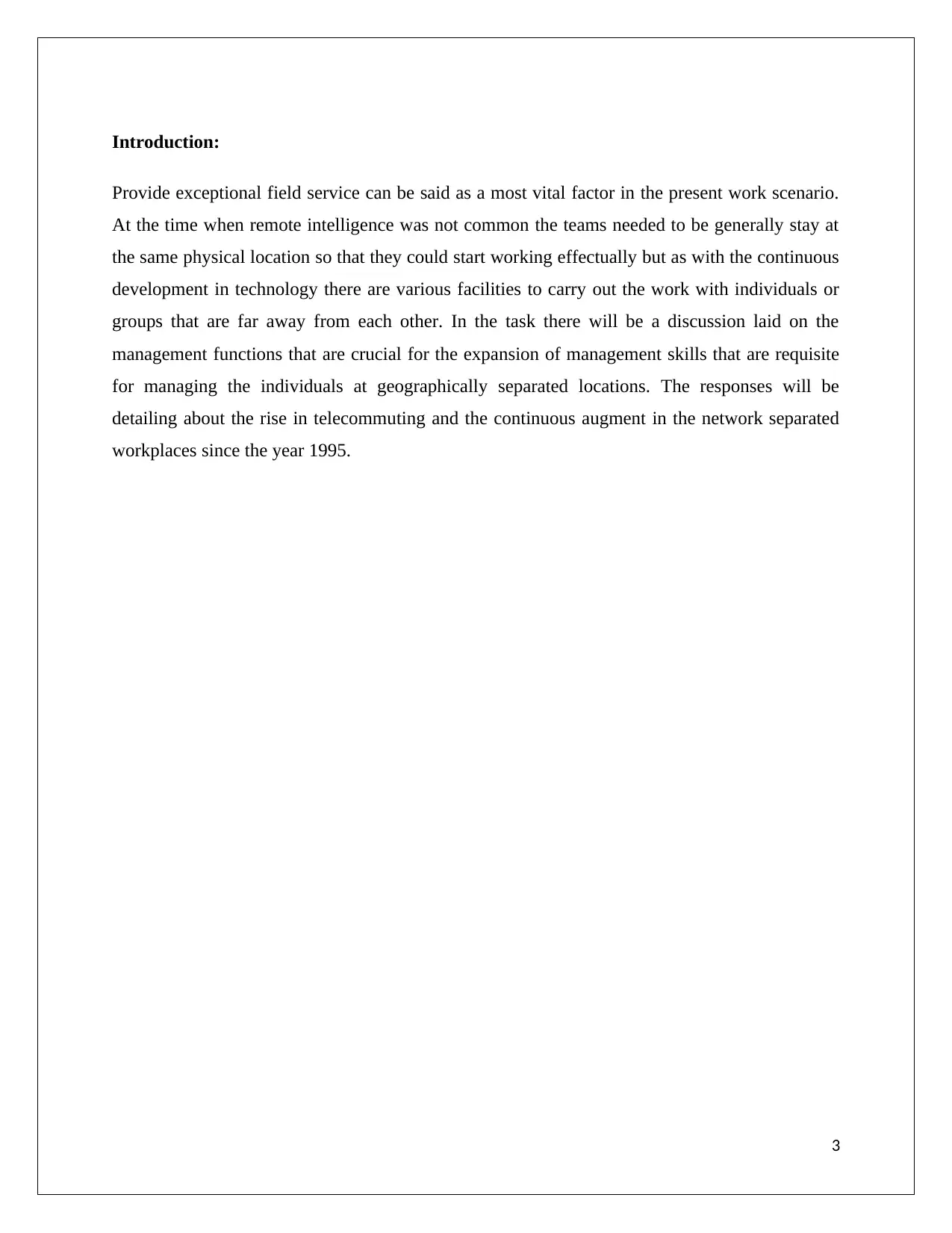
Introduction:
Provide exceptional field service can be said as a most vital factor in the present work scenario.
At the time when remote intelligence was not common the teams needed to be generally stay at
the same physical location so that they could start working effectually but as with the continuous
development in technology there are various facilities to carry out the work with individuals or
groups that are far away from each other. In the task there will be a discussion laid on the
management functions that are crucial for the expansion of management skills that are requisite
for managing the individuals at geographically separated locations. The responses will be
detailing about the rise in telecommuting and the continuous augment in the network separated
workplaces since the year 1995.
3
Provide exceptional field service can be said as a most vital factor in the present work scenario.
At the time when remote intelligence was not common the teams needed to be generally stay at
the same physical location so that they could start working effectually but as with the continuous
development in technology there are various facilities to carry out the work with individuals or
groups that are far away from each other. In the task there will be a discussion laid on the
management functions that are crucial for the expansion of management skills that are requisite
for managing the individuals at geographically separated locations. The responses will be
detailing about the rise in telecommuting and the continuous augment in the network separated
workplaces since the year 1995.
3
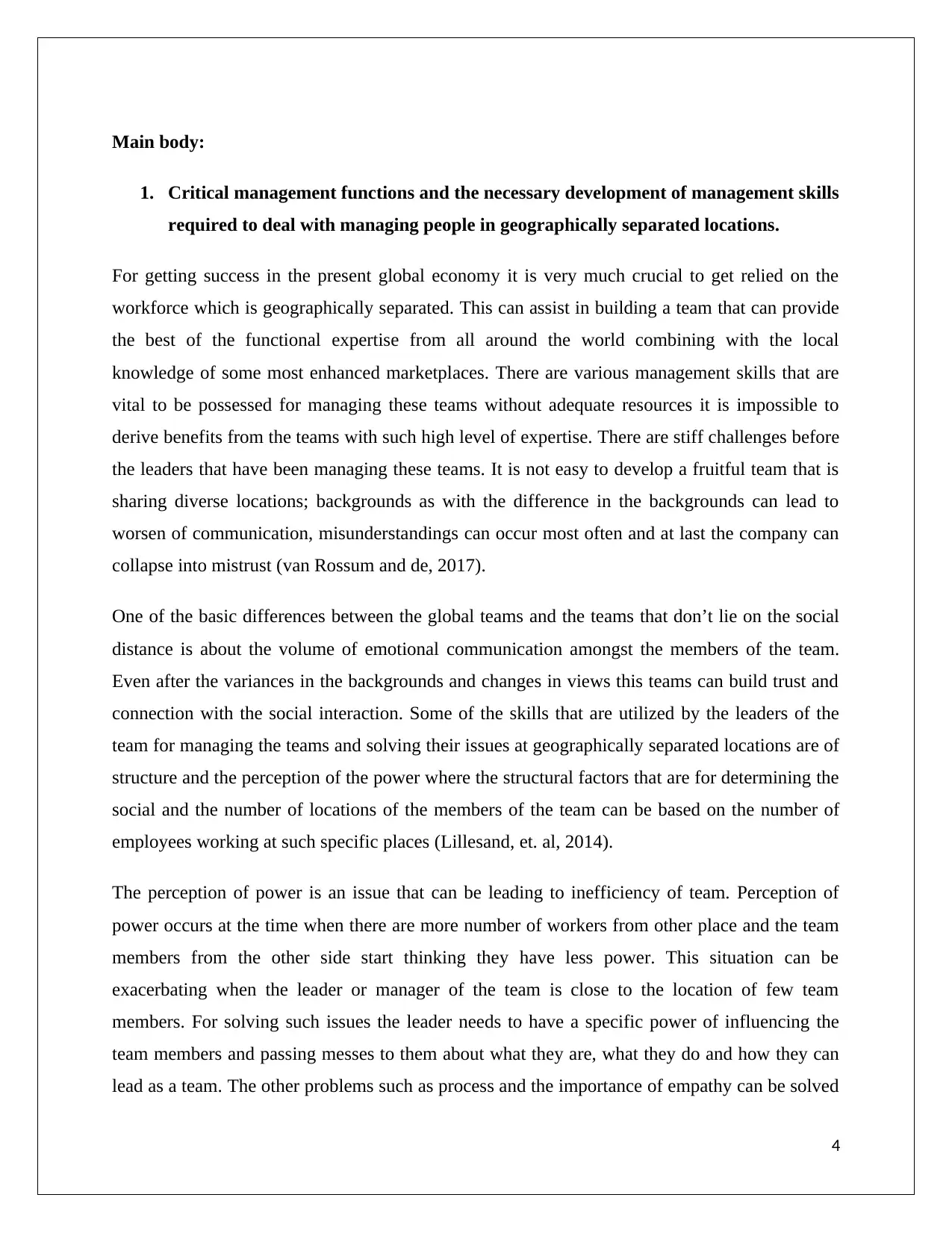
Main body:
1. Critical management functions and the necessary development of management skills
required to deal with managing people in geographically separated locations.
For getting success in the present global economy it is very much crucial to get relied on the
workforce which is geographically separated. This can assist in building a team that can provide
the best of the functional expertise from all around the world combining with the local
knowledge of some most enhanced marketplaces. There are various management skills that are
vital to be possessed for managing these teams without adequate resources it is impossible to
derive benefits from the teams with such high level of expertise. There are stiff challenges before
the leaders that have been managing these teams. It is not easy to develop a fruitful team that is
sharing diverse locations; backgrounds as with the difference in the backgrounds can lead to
worsen of communication, misunderstandings can occur most often and at last the company can
collapse into mistrust (van Rossum and de, 2017).
One of the basic differences between the global teams and the teams that don’t lie on the social
distance is about the volume of emotional communication amongst the members of the team.
Even after the variances in the backgrounds and changes in views this teams can build trust and
connection with the social interaction. Some of the skills that are utilized by the leaders of the
team for managing the teams and solving their issues at geographically separated locations are of
structure and the perception of the power where the structural factors that are for determining the
social and the number of locations of the members of the team can be based on the number of
employees working at such specific places (Lillesand, et. al, 2014).
The perception of power is an issue that can be leading to inefficiency of team. Perception of
power occurs at the time when there are more number of workers from other place and the team
members from the other side start thinking they have less power. This situation can be
exacerbating when the leader or manager of the team is close to the location of few team
members. For solving such issues the leader needs to have a specific power of influencing the
team members and passing messes to them about what they are, what they do and how they can
lead as a team. The other problems such as process and the importance of empathy can be solved
4
1. Critical management functions and the necessary development of management skills
required to deal with managing people in geographically separated locations.
For getting success in the present global economy it is very much crucial to get relied on the
workforce which is geographically separated. This can assist in building a team that can provide
the best of the functional expertise from all around the world combining with the local
knowledge of some most enhanced marketplaces. There are various management skills that are
vital to be possessed for managing these teams without adequate resources it is impossible to
derive benefits from the teams with such high level of expertise. There are stiff challenges before
the leaders that have been managing these teams. It is not easy to develop a fruitful team that is
sharing diverse locations; backgrounds as with the difference in the backgrounds can lead to
worsen of communication, misunderstandings can occur most often and at last the company can
collapse into mistrust (van Rossum and de, 2017).
One of the basic differences between the global teams and the teams that don’t lie on the social
distance is about the volume of emotional communication amongst the members of the team.
Even after the variances in the backgrounds and changes in views this teams can build trust and
connection with the social interaction. Some of the skills that are utilized by the leaders of the
team for managing the teams and solving their issues at geographically separated locations are of
structure and the perception of the power where the structural factors that are for determining the
social and the number of locations of the members of the team can be based on the number of
employees working at such specific places (Lillesand, et. al, 2014).
The perception of power is an issue that can be leading to inefficiency of team. Perception of
power occurs at the time when there are more number of workers from other place and the team
members from the other side start thinking they have less power. This situation can be
exacerbating when the leader or manager of the team is close to the location of few team
members. For solving such issues the leader needs to have a specific power of influencing the
team members and passing messes to them about what they are, what they do and how they can
lead as a team. The other problems such as process and the importance of empathy can be solved
4
Secure Best Marks with AI Grader
Need help grading? Try our AI Grader for instant feedback on your assignments.
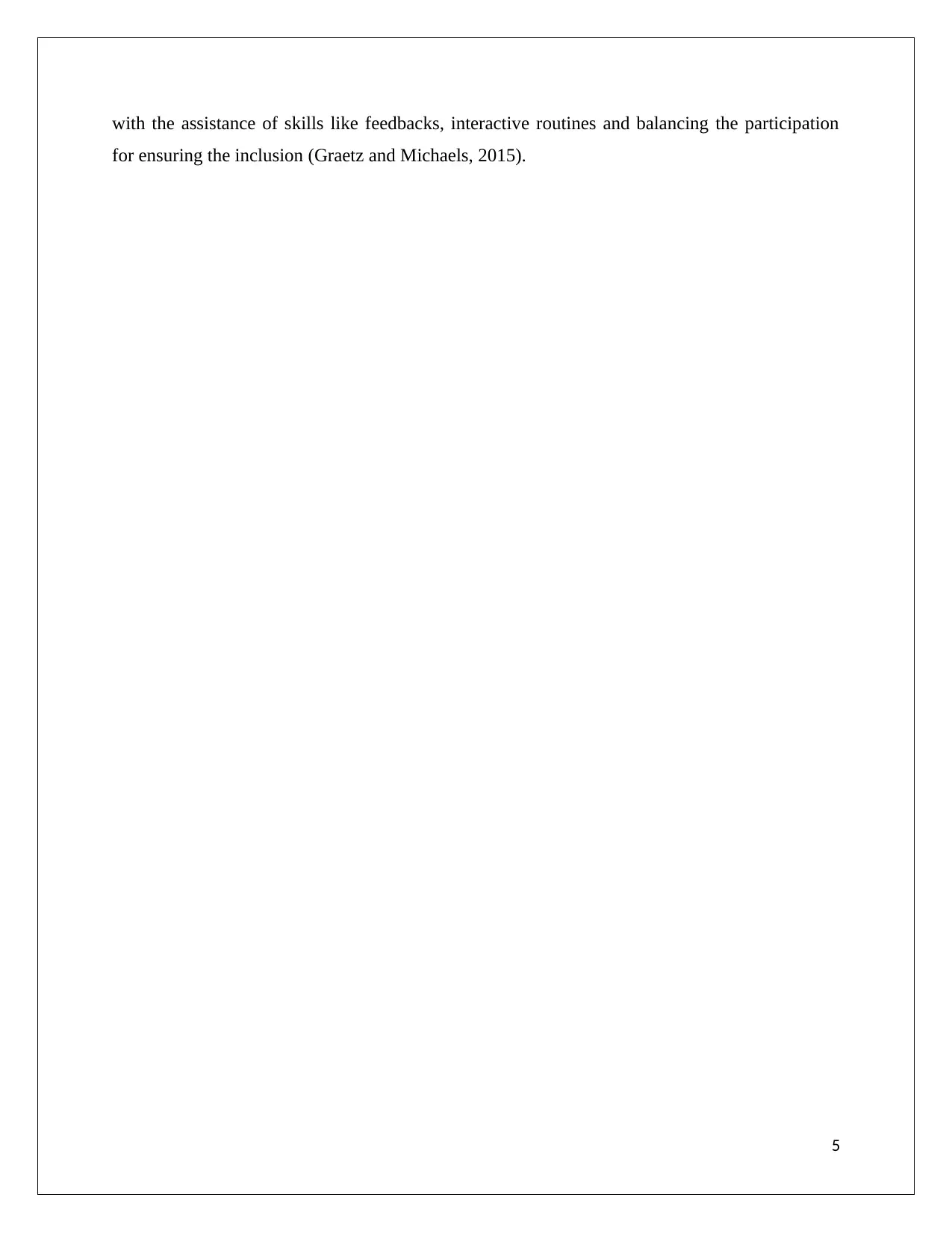
with the assistance of skills like feedbacks, interactive routines and balancing the participation
for ensuring the inclusion (Graetz and Michaels, 2015).
5
for ensuring the inclusion (Graetz and Michaels, 2015).
5
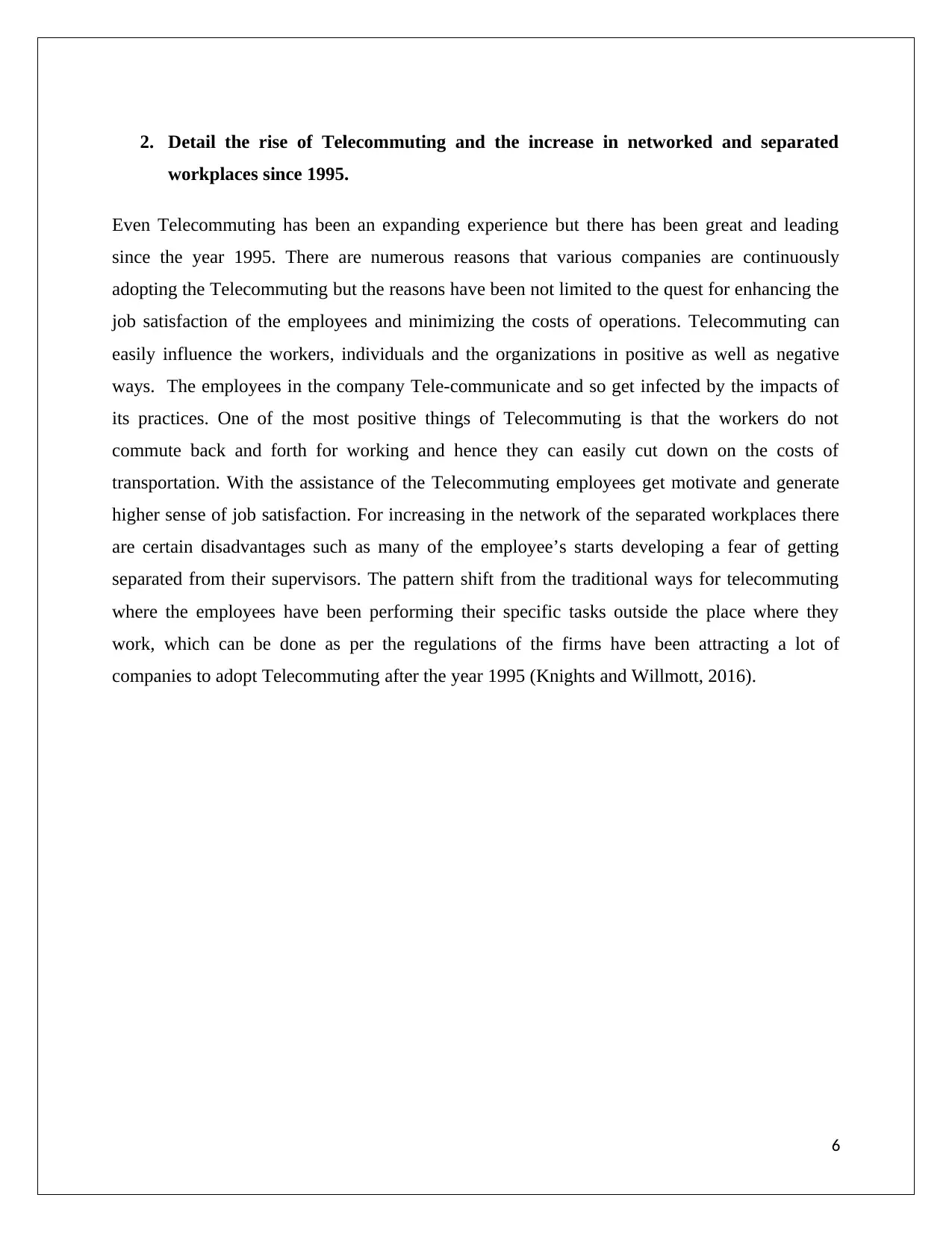
2. Detail the rise of Telecommuting and the increase in networked and separated
workplaces since 1995.
Even Telecommuting has been an expanding experience but there has been great and leading
since the year 1995. There are numerous reasons that various companies are continuously
adopting the Telecommuting but the reasons have been not limited to the quest for enhancing the
job satisfaction of the employees and minimizing the costs of operations. Telecommuting can
easily influence the workers, individuals and the organizations in positive as well as negative
ways. The employees in the company Tele-communicate and so get infected by the impacts of
its practices. One of the most positive things of Telecommuting is that the workers do not
commute back and forth for working and hence they can easily cut down on the costs of
transportation. With the assistance of the Telecommuting employees get motivate and generate
higher sense of job satisfaction. For increasing in the network of the separated workplaces there
are certain disadvantages such as many of the employee’s starts developing a fear of getting
separated from their supervisors. The pattern shift from the traditional ways for telecommuting
where the employees have been performing their specific tasks outside the place where they
work, which can be done as per the regulations of the firms have been attracting a lot of
companies to adopt Telecommuting after the year 1995 (Knights and Willmott, 2016).
6
workplaces since 1995.
Even Telecommuting has been an expanding experience but there has been great and leading
since the year 1995. There are numerous reasons that various companies are continuously
adopting the Telecommuting but the reasons have been not limited to the quest for enhancing the
job satisfaction of the employees and minimizing the costs of operations. Telecommuting can
easily influence the workers, individuals and the organizations in positive as well as negative
ways. The employees in the company Tele-communicate and so get infected by the impacts of
its practices. One of the most positive things of Telecommuting is that the workers do not
commute back and forth for working and hence they can easily cut down on the costs of
transportation. With the assistance of the Telecommuting employees get motivate and generate
higher sense of job satisfaction. For increasing in the network of the separated workplaces there
are certain disadvantages such as many of the employee’s starts developing a fear of getting
separated from their supervisors. The pattern shift from the traditional ways for telecommuting
where the employees have been performing their specific tasks outside the place where they
work, which can be done as per the regulations of the firms have been attracting a lot of
companies to adopt Telecommuting after the year 1995 (Knights and Willmott, 2016).
6
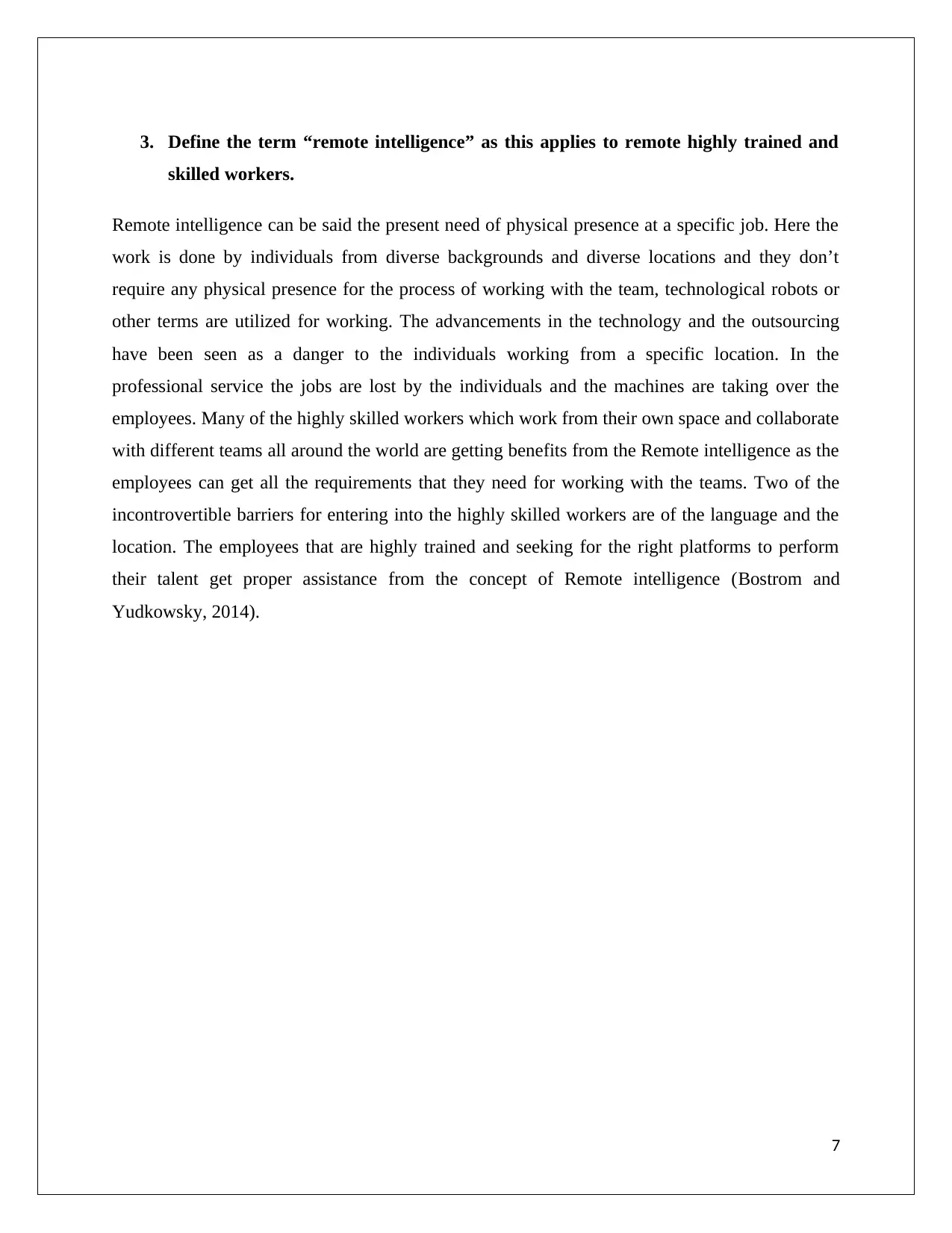
3. Define the term “remote intelligence” as this applies to remote highly trained and
skilled workers.
Remote intelligence can be said the present need of physical presence at a specific job. Here the
work is done by individuals from diverse backgrounds and diverse locations and they don’t
require any physical presence for the process of working with the team, technological robots or
other terms are utilized for working. The advancements in the technology and the outsourcing
have been seen as a danger to the individuals working from a specific location. In the
professional service the jobs are lost by the individuals and the machines are taking over the
employees. Many of the highly skilled workers which work from their own space and collaborate
with different teams all around the world are getting benefits from the Remote intelligence as the
employees can get all the requirements that they need for working with the teams. Two of the
incontrovertible barriers for entering into the highly skilled workers are of the language and the
location. The employees that are highly trained and seeking for the right platforms to perform
their talent get proper assistance from the concept of Remote intelligence (Bostrom and
Yudkowsky, 2014).
7
skilled workers.
Remote intelligence can be said the present need of physical presence at a specific job. Here the
work is done by individuals from diverse backgrounds and diverse locations and they don’t
require any physical presence for the process of working with the team, technological robots or
other terms are utilized for working. The advancements in the technology and the outsourcing
have been seen as a danger to the individuals working from a specific location. In the
professional service the jobs are lost by the individuals and the machines are taking over the
employees. Many of the highly skilled workers which work from their own space and collaborate
with different teams all around the world are getting benefits from the Remote intelligence as the
employees can get all the requirements that they need for working with the teams. Two of the
incontrovertible barriers for entering into the highly skilled workers are of the language and the
location. The employees that are highly trained and seeking for the right platforms to perform
their talent get proper assistance from the concept of Remote intelligence (Bostrom and
Yudkowsky, 2014).
7
Paraphrase This Document
Need a fresh take? Get an instant paraphrase of this document with our AI Paraphraser
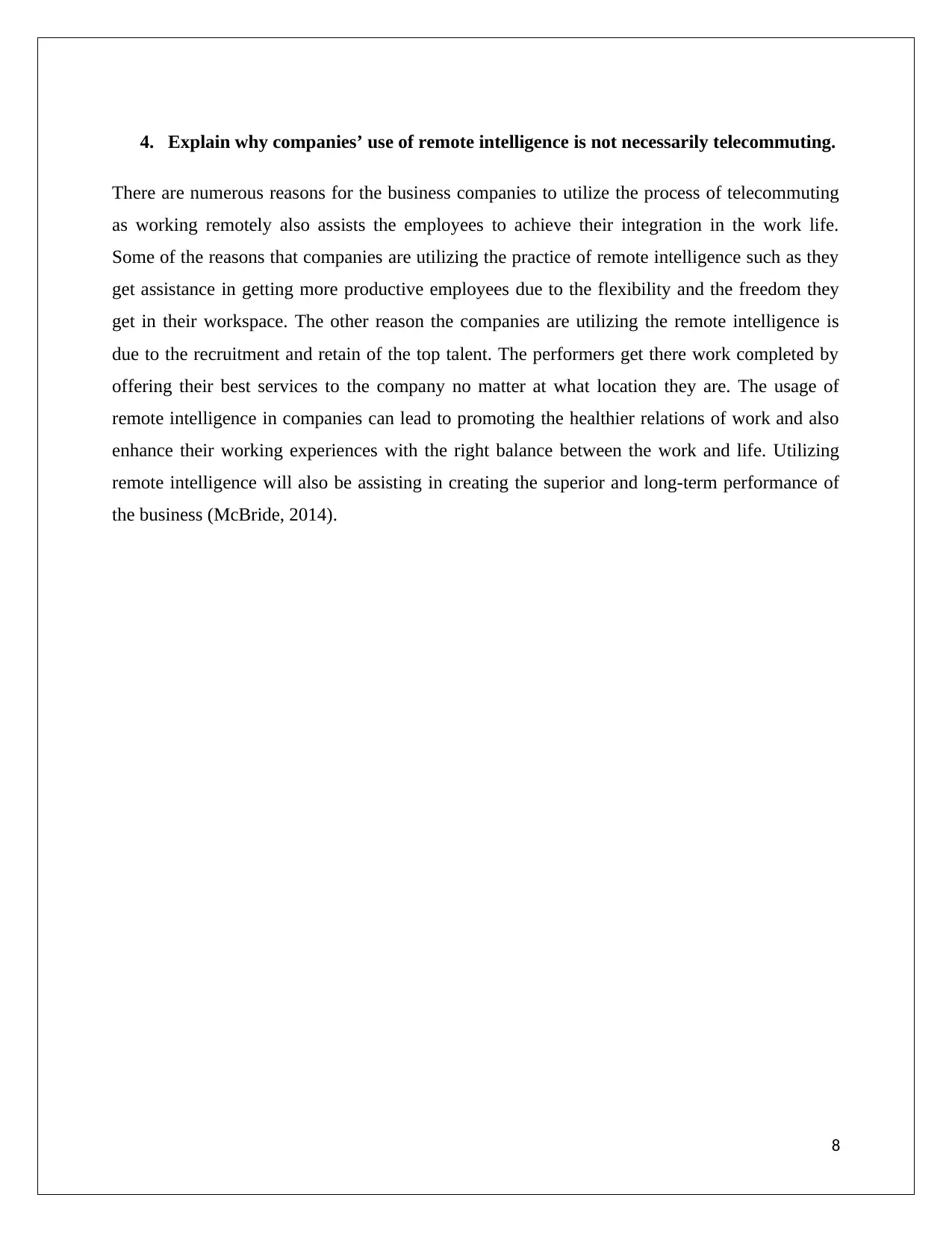
4. Explain why companies’ use of remote intelligence is not necessarily telecommuting.
There are numerous reasons for the business companies to utilize the process of telecommuting
as working remotely also assists the employees to achieve their integration in the work life.
Some of the reasons that companies are utilizing the practice of remote intelligence such as they
get assistance in getting more productive employees due to the flexibility and the freedom they
get in their workspace. The other reason the companies are utilizing the remote intelligence is
due to the recruitment and retain of the top talent. The performers get there work completed by
offering their best services to the company no matter at what location they are. The usage of
remote intelligence in companies can lead to promoting the healthier relations of work and also
enhance their working experiences with the right balance between the work and life. Utilizing
remote intelligence will also be assisting in creating the superior and long-term performance of
the business (McBride, 2014).
8
There are numerous reasons for the business companies to utilize the process of telecommuting
as working remotely also assists the employees to achieve their integration in the work life.
Some of the reasons that companies are utilizing the practice of remote intelligence such as they
get assistance in getting more productive employees due to the flexibility and the freedom they
get in their workspace. The other reason the companies are utilizing the remote intelligence is
due to the recruitment and retain of the top talent. The performers get there work completed by
offering their best services to the company no matter at what location they are. The usage of
remote intelligence in companies can lead to promoting the healthier relations of work and also
enhance their working experiences with the right balance between the work and life. Utilizing
remote intelligence will also be assisting in creating the superior and long-term performance of
the business (McBride, 2014).
8
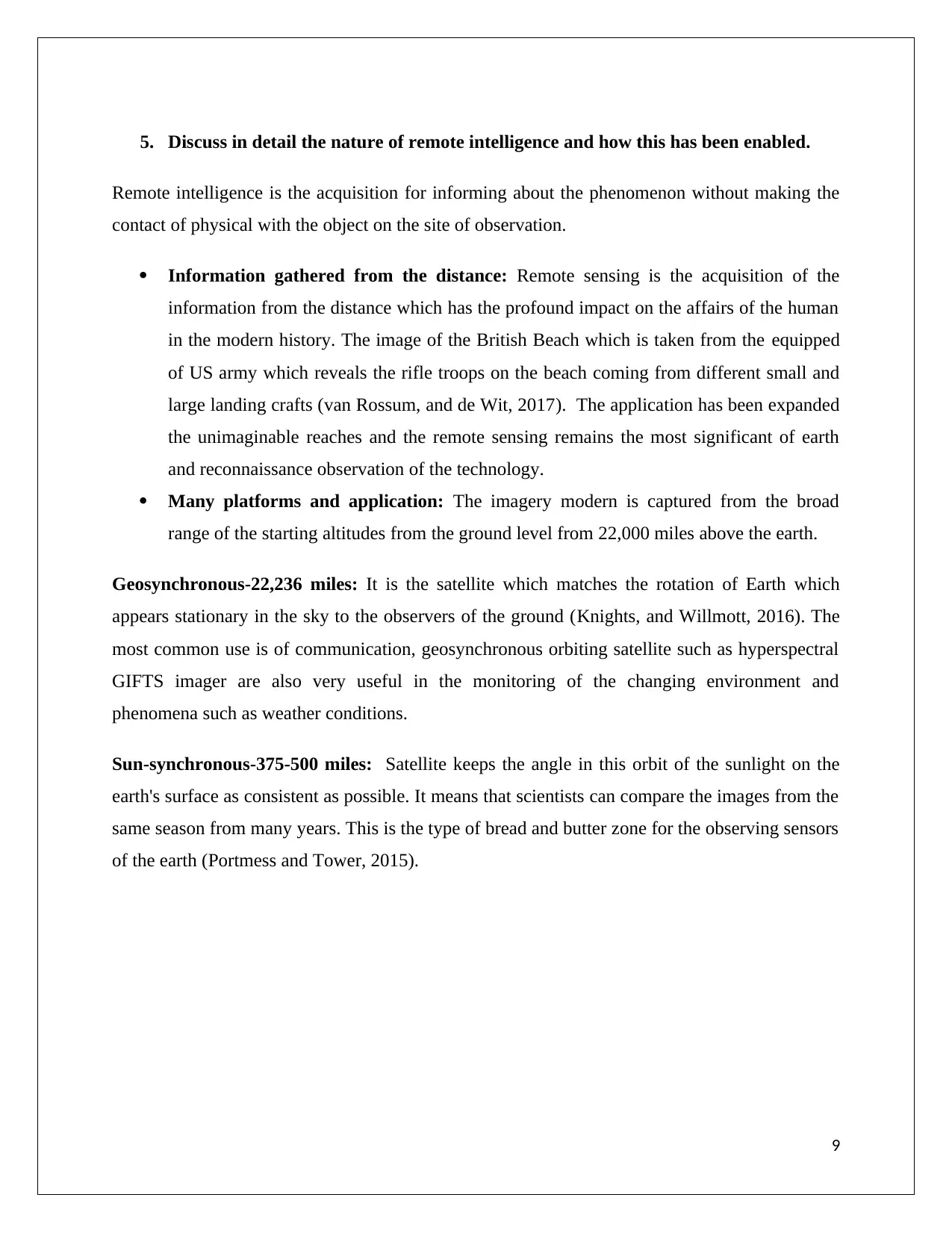
5. Discuss in detail the nature of remote intelligence and how this has been enabled.
Remote intelligence is the acquisition for informing about the phenomenon without making the
contact of physical with the object on the site of observation.
Information gathered from the distance: Remote sensing is the acquisition of the
information from the distance which has the profound impact on the affairs of the human
in the modern history. The image of the British Beach which is taken from the equipped
of US army which reveals the rifle troops on the beach coming from different small and
large landing crafts (van Rossum, and de Wit, 2017). The application has been expanded
the unimaginable reaches and the remote sensing remains the most significant of earth
and reconnaissance observation of the technology.
Many platforms and application: The imagery modern is captured from the broad
range of the starting altitudes from the ground level from 22,000 miles above the earth.
Geosynchronous-22,236 miles: It is the satellite which matches the rotation of Earth which
appears stationary in the sky to the observers of the ground (Knights, and Willmott, 2016). The
most common use is of communication, geosynchronous orbiting satellite such as hyperspectral
GIFTS imager are also very useful in the monitoring of the changing environment and
phenomena such as weather conditions.
Sun-synchronous-375-500 miles: Satellite keeps the angle in this orbit of the sunlight on the
earth's surface as consistent as possible. It means that scientists can compare the images from the
same season from many years. This is the type of bread and butter zone for the observing sensors
of the earth (Portmess and Tower, 2015).
9
Remote intelligence is the acquisition for informing about the phenomenon without making the
contact of physical with the object on the site of observation.
Information gathered from the distance: Remote sensing is the acquisition of the
information from the distance which has the profound impact on the affairs of the human
in the modern history. The image of the British Beach which is taken from the equipped
of US army which reveals the rifle troops on the beach coming from different small and
large landing crafts (van Rossum, and de Wit, 2017). The application has been expanded
the unimaginable reaches and the remote sensing remains the most significant of earth
and reconnaissance observation of the technology.
Many platforms and application: The imagery modern is captured from the broad
range of the starting altitudes from the ground level from 22,000 miles above the earth.
Geosynchronous-22,236 miles: It is the satellite which matches the rotation of Earth which
appears stationary in the sky to the observers of the ground (Knights, and Willmott, 2016). The
most common use is of communication, geosynchronous orbiting satellite such as hyperspectral
GIFTS imager are also very useful in the monitoring of the changing environment and
phenomena such as weather conditions.
Sun-synchronous-375-500 miles: Satellite keeps the angle in this orbit of the sunlight on the
earth's surface as consistent as possible. It means that scientists can compare the images from the
same season from many years. This is the type of bread and butter zone for the observing sensors
of the earth (Portmess and Tower, 2015).
9
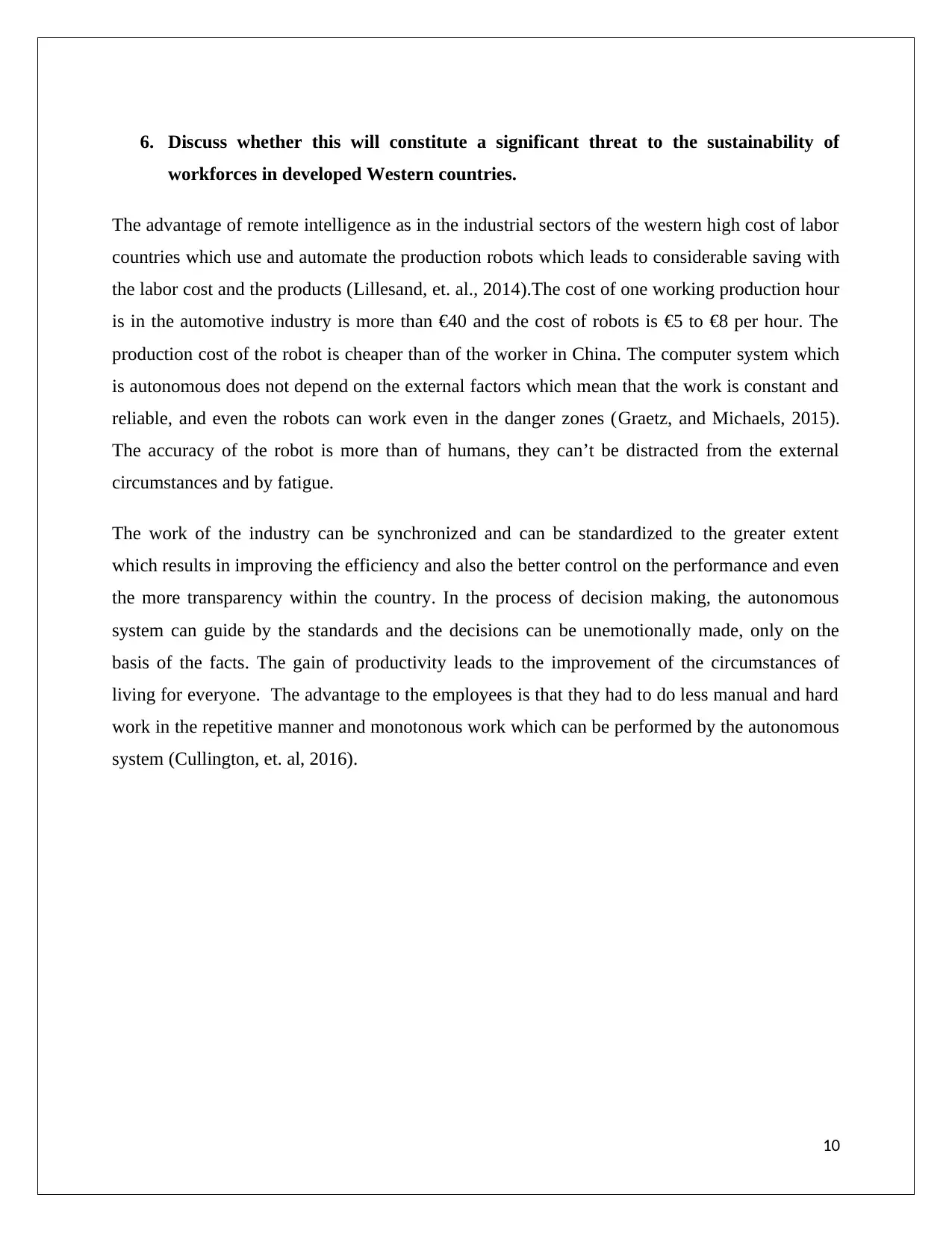
6. Discuss whether this will constitute a significant threat to the sustainability of
workforces in developed Western countries.
The advantage of remote intelligence as in the industrial sectors of the western high cost of labor
countries which use and automate the production robots which leads to considerable saving with
the labor cost and the products (Lillesand, et. al., 2014).The cost of one working production hour
is in the automotive industry is more than €40 and the cost of robots is €5 to €8 per hour. The
production cost of the robot is cheaper than of the worker in China. The computer system which
is autonomous does not depend on the external factors which mean that the work is constant and
reliable, and even the robots can work even in the danger zones (Graetz, and Michaels, 2015).
The accuracy of the robot is more than of humans, they can’t be distracted from the external
circumstances and by fatigue.
The work of the industry can be synchronized and can be standardized to the greater extent
which results in improving the efficiency and also the better control on the performance and even
the more transparency within the country. In the process of decision making, the autonomous
system can guide by the standards and the decisions can be unemotionally made, only on the
basis of the facts. The gain of productivity leads to the improvement of the circumstances of
living for everyone. The advantage to the employees is that they had to do less manual and hard
work in the repetitive manner and monotonous work which can be performed by the autonomous
system (Cullington, et. al, 2016).
10
workforces in developed Western countries.
The advantage of remote intelligence as in the industrial sectors of the western high cost of labor
countries which use and automate the production robots which leads to considerable saving with
the labor cost and the products (Lillesand, et. al., 2014).The cost of one working production hour
is in the automotive industry is more than €40 and the cost of robots is €5 to €8 per hour. The
production cost of the robot is cheaper than of the worker in China. The computer system which
is autonomous does not depend on the external factors which mean that the work is constant and
reliable, and even the robots can work even in the danger zones (Graetz, and Michaels, 2015).
The accuracy of the robot is more than of humans, they can’t be distracted from the external
circumstances and by fatigue.
The work of the industry can be synchronized and can be standardized to the greater extent
which results in improving the efficiency and also the better control on the performance and even
the more transparency within the country. In the process of decision making, the autonomous
system can guide by the standards and the decisions can be unemotionally made, only on the
basis of the facts. The gain of productivity leads to the improvement of the circumstances of
living for everyone. The advantage to the employees is that they had to do less manual and hard
work in the repetitive manner and monotonous work which can be performed by the autonomous
system (Cullington, et. al, 2016).
10
Secure Best Marks with AI Grader
Need help grading? Try our AI Grader for instant feedback on your assignments.
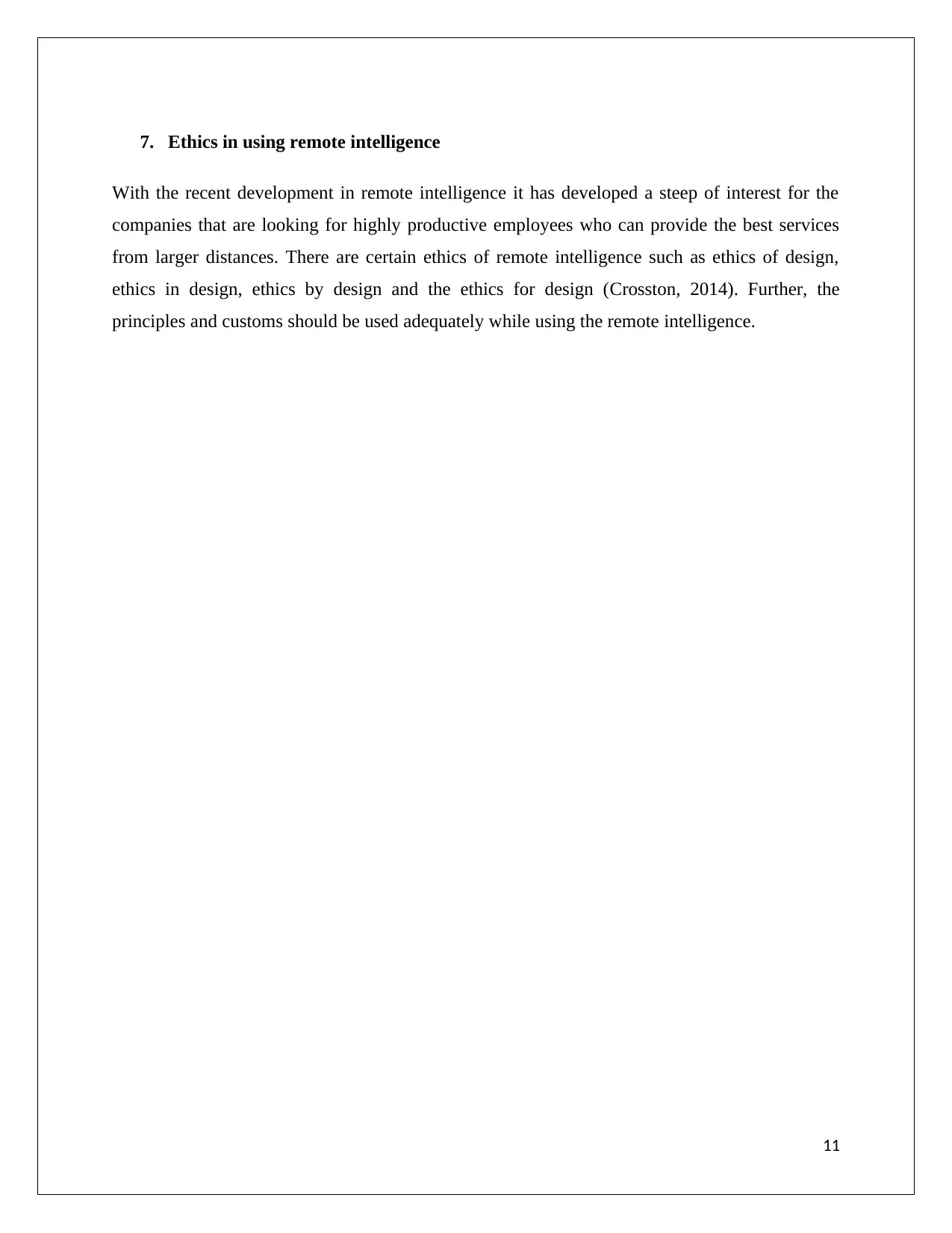
7. Ethics in using remote intelligence
With the recent development in remote intelligence it has developed a steep of interest for the
companies that are looking for highly productive employees who can provide the best services
from larger distances. There are certain ethics of remote intelligence such as ethics of design,
ethics in design, ethics by design and the ethics for design (Crosston, 2014). Further, the
principles and customs should be used adequately while using the remote intelligence.
11
With the recent development in remote intelligence it has developed a steep of interest for the
companies that are looking for highly productive employees who can provide the best services
from larger distances. There are certain ethics of remote intelligence such as ethics of design,
ethics in design, ethics by design and the ethics for design (Crosston, 2014). Further, the
principles and customs should be used adequately while using the remote intelligence.
11
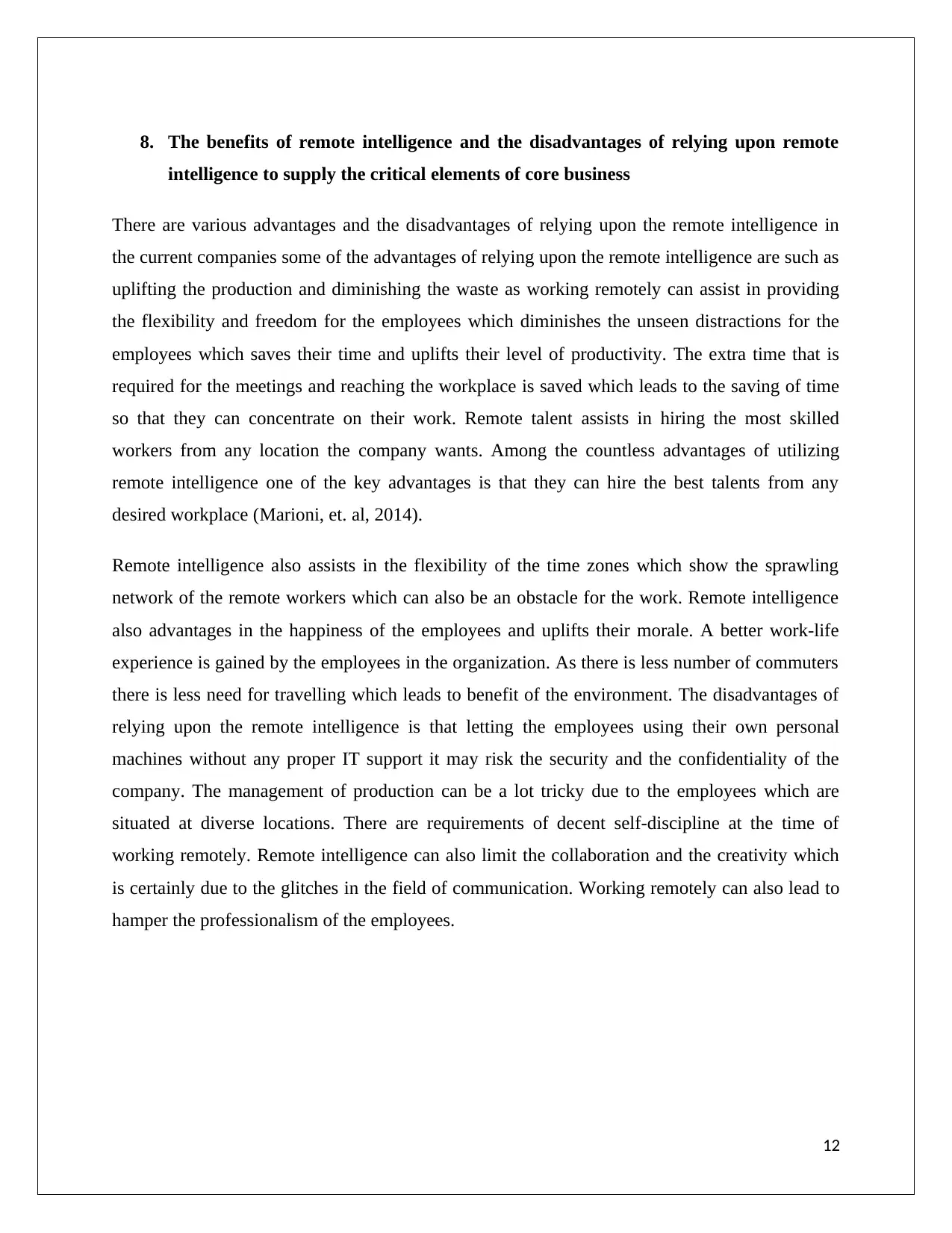
8. The benefits of remote intelligence and the disadvantages of relying upon remote
intelligence to supply the critical elements of core business
There are various advantages and the disadvantages of relying upon the remote intelligence in
the current companies some of the advantages of relying upon the remote intelligence are such as
uplifting the production and diminishing the waste as working remotely can assist in providing
the flexibility and freedom for the employees which diminishes the unseen distractions for the
employees which saves their time and uplifts their level of productivity. The extra time that is
required for the meetings and reaching the workplace is saved which leads to the saving of time
so that they can concentrate on their work. Remote talent assists in hiring the most skilled
workers from any location the company wants. Among the countless advantages of utilizing
remote intelligence one of the key advantages is that they can hire the best talents from any
desired workplace (Marioni, et. al, 2014).
Remote intelligence also assists in the flexibility of the time zones which show the sprawling
network of the remote workers which can also be an obstacle for the work. Remote intelligence
also advantages in the happiness of the employees and uplifts their morale. A better work-life
experience is gained by the employees in the organization. As there is less number of commuters
there is less need for travelling which leads to benefit of the environment. The disadvantages of
relying upon the remote intelligence is that letting the employees using their own personal
machines without any proper IT support it may risk the security and the confidentiality of the
company. The management of production can be a lot tricky due to the employees which are
situated at diverse locations. There are requirements of decent self-discipline at the time of
working remotely. Remote intelligence can also limit the collaboration and the creativity which
is certainly due to the glitches in the field of communication. Working remotely can also lead to
hamper the professionalism of the employees.
12
intelligence to supply the critical elements of core business
There are various advantages and the disadvantages of relying upon the remote intelligence in
the current companies some of the advantages of relying upon the remote intelligence are such as
uplifting the production and diminishing the waste as working remotely can assist in providing
the flexibility and freedom for the employees which diminishes the unseen distractions for the
employees which saves their time and uplifts their level of productivity. The extra time that is
required for the meetings and reaching the workplace is saved which leads to the saving of time
so that they can concentrate on their work. Remote talent assists in hiring the most skilled
workers from any location the company wants. Among the countless advantages of utilizing
remote intelligence one of the key advantages is that they can hire the best talents from any
desired workplace (Marioni, et. al, 2014).
Remote intelligence also assists in the flexibility of the time zones which show the sprawling
network of the remote workers which can also be an obstacle for the work. Remote intelligence
also advantages in the happiness of the employees and uplifts their morale. A better work-life
experience is gained by the employees in the organization. As there is less number of commuters
there is less need for travelling which leads to benefit of the environment. The disadvantages of
relying upon the remote intelligence is that letting the employees using their own personal
machines without any proper IT support it may risk the security and the confidentiality of the
company. The management of production can be a lot tricky due to the employees which are
situated at diverse locations. There are requirements of decent self-discipline at the time of
working remotely. Remote intelligence can also limit the collaboration and the creativity which
is certainly due to the glitches in the field of communication. Working remotely can also lead to
hamper the professionalism of the employees.
12
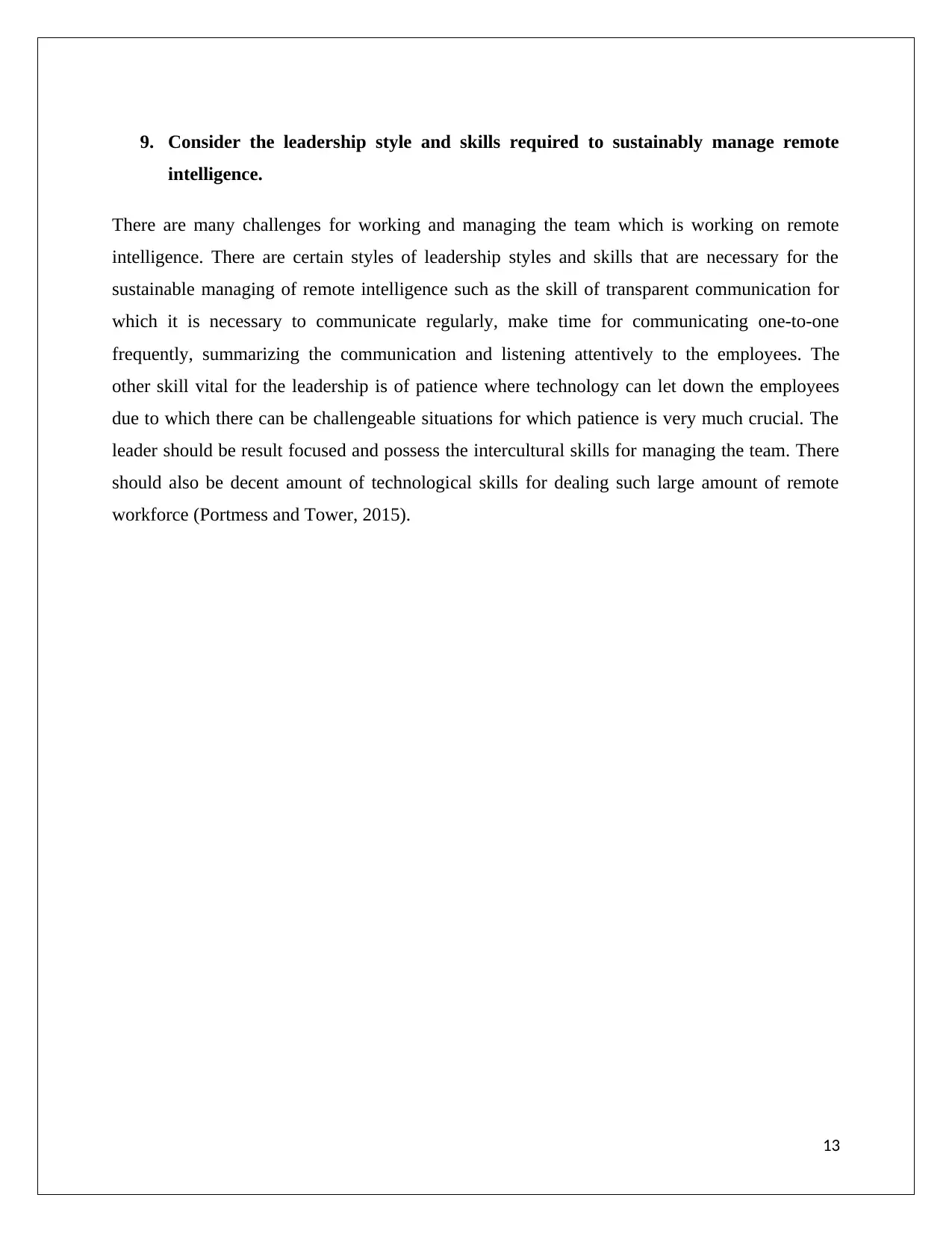
9. Consider the leadership style and skills required to sustainably manage remote
intelligence.
There are many challenges for working and managing the team which is working on remote
intelligence. There are certain styles of leadership styles and skills that are necessary for the
sustainable managing of remote intelligence such as the skill of transparent communication for
which it is necessary to communicate regularly, make time for communicating one-to-one
frequently, summarizing the communication and listening attentively to the employees. The
other skill vital for the leadership is of patience where technology can let down the employees
due to which there can be challengeable situations for which patience is very much crucial. The
leader should be result focused and possess the intercultural skills for managing the team. There
should also be decent amount of technological skills for dealing such large amount of remote
workforce (Portmess and Tower, 2015).
13
intelligence.
There are many challenges for working and managing the team which is working on remote
intelligence. There are certain styles of leadership styles and skills that are necessary for the
sustainable managing of remote intelligence such as the skill of transparent communication for
which it is necessary to communicate regularly, make time for communicating one-to-one
frequently, summarizing the communication and listening attentively to the employees. The
other skill vital for the leadership is of patience where technology can let down the employees
due to which there can be challengeable situations for which patience is very much crucial. The
leader should be result focused and possess the intercultural skills for managing the team. There
should also be decent amount of technological skills for dealing such large amount of remote
workforce (Portmess and Tower, 2015).
13
Paraphrase This Document
Need a fresh take? Get an instant paraphrase of this document with our AI Paraphraser
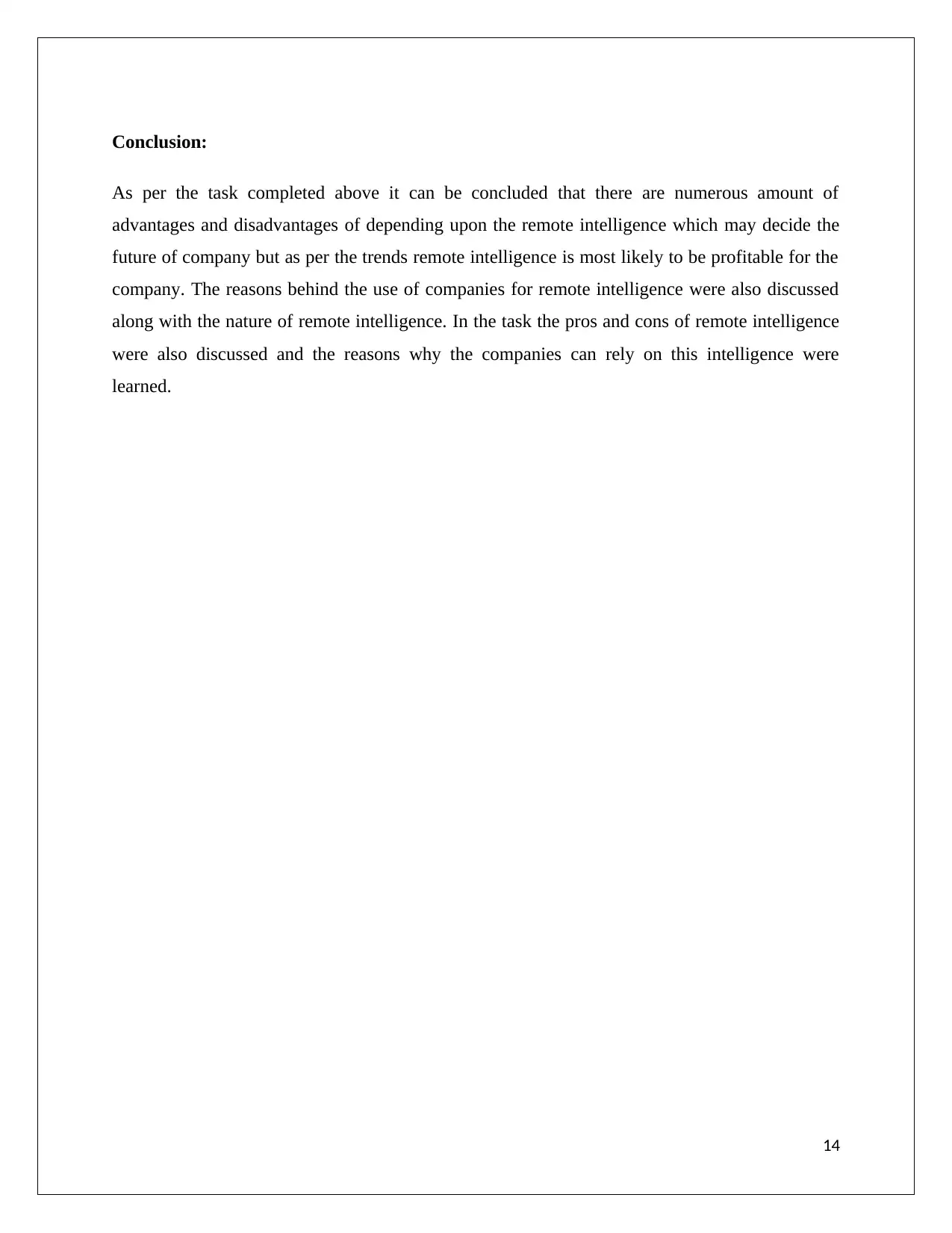
Conclusion:
As per the task completed above it can be concluded that there are numerous amount of
advantages and disadvantages of depending upon the remote intelligence which may decide the
future of company but as per the trends remote intelligence is most likely to be profitable for the
company. The reasons behind the use of companies for remote intelligence were also discussed
along with the nature of remote intelligence. In the task the pros and cons of remote intelligence
were also discussed and the reasons why the companies can rely on this intelligence were
learned.
14
As per the task completed above it can be concluded that there are numerous amount of
advantages and disadvantages of depending upon the remote intelligence which may decide the
future of company but as per the trends remote intelligence is most likely to be profitable for the
company. The reasons behind the use of companies for remote intelligence were also discussed
along with the nature of remote intelligence. In the task the pros and cons of remote intelligence
were also discussed and the reasons why the companies can rely on this intelligence were
learned.
14
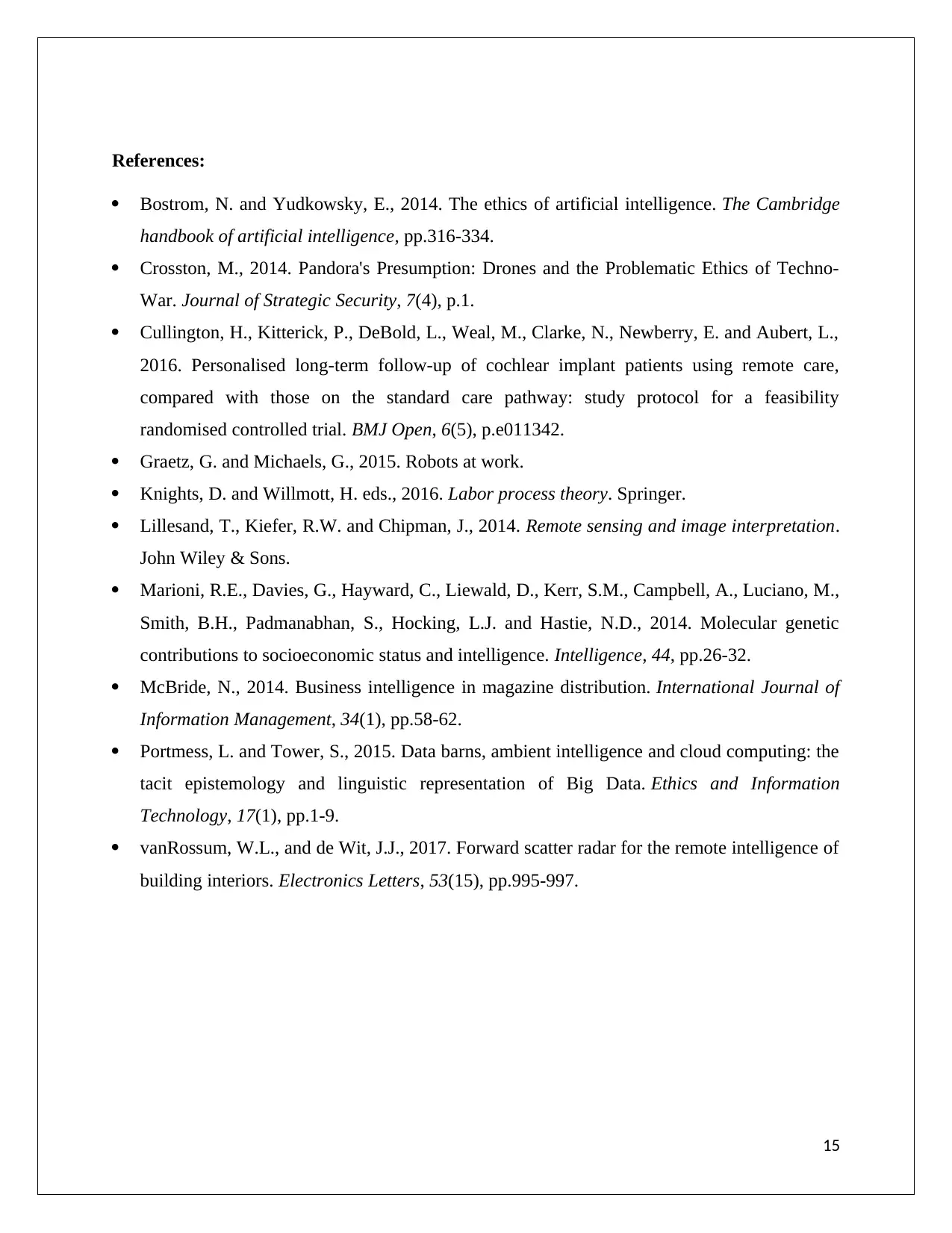
References:
Bostrom, N. and Yudkowsky, E., 2014. The ethics of artificial intelligence. The Cambridge
handbook of artificial intelligence, pp.316-334.
Crosston, M., 2014. Pandora's Presumption: Drones and the Problematic Ethics of Techno-
War. Journal of Strategic Security, 7(4), p.1.
Cullington, H., Kitterick, P., DeBold, L., Weal, M., Clarke, N., Newberry, E. and Aubert, L.,
2016. Personalised long-term follow-up of cochlear implant patients using remote care,
compared with those on the standard care pathway: study protocol for a feasibility
randomised controlled trial. BMJ Open, 6(5), p.e011342.
Graetz, G. and Michaels, G., 2015. Robots at work.
Knights, D. and Willmott, H. eds., 2016. Labor process theory. Springer.
Lillesand, T., Kiefer, R.W. and Chipman, J., 2014. Remote sensing and image interpretation.
John Wiley & Sons.
Marioni, R.E., Davies, G., Hayward, C., Liewald, D., Kerr, S.M., Campbell, A., Luciano, M.,
Smith, B.H., Padmanabhan, S., Hocking, L.J. and Hastie, N.D., 2014. Molecular genetic
contributions to socioeconomic status and intelligence. Intelligence, 44, pp.26-32.
McBride, N., 2014. Business intelligence in magazine distribution. International Journal of
Information Management, 34(1), pp.58-62.
Portmess, L. and Tower, S., 2015. Data barns, ambient intelligence and cloud computing: the
tacit epistemology and linguistic representation of Big Data. Ethics and Information
Technology, 17(1), pp.1-9.
vanRossum, W.L., and de Wit, J.J., 2017. Forward scatter radar for the remote intelligence of
building interiors. Electronics Letters, 53(15), pp.995-997.
15
Bostrom, N. and Yudkowsky, E., 2014. The ethics of artificial intelligence. The Cambridge
handbook of artificial intelligence, pp.316-334.
Crosston, M., 2014. Pandora's Presumption: Drones and the Problematic Ethics of Techno-
War. Journal of Strategic Security, 7(4), p.1.
Cullington, H., Kitterick, P., DeBold, L., Weal, M., Clarke, N., Newberry, E. and Aubert, L.,
2016. Personalised long-term follow-up of cochlear implant patients using remote care,
compared with those on the standard care pathway: study protocol for a feasibility
randomised controlled trial. BMJ Open, 6(5), p.e011342.
Graetz, G. and Michaels, G., 2015. Robots at work.
Knights, D. and Willmott, H. eds., 2016. Labor process theory. Springer.
Lillesand, T., Kiefer, R.W. and Chipman, J., 2014. Remote sensing and image interpretation.
John Wiley & Sons.
Marioni, R.E., Davies, G., Hayward, C., Liewald, D., Kerr, S.M., Campbell, A., Luciano, M.,
Smith, B.H., Padmanabhan, S., Hocking, L.J. and Hastie, N.D., 2014. Molecular genetic
contributions to socioeconomic status and intelligence. Intelligence, 44, pp.26-32.
McBride, N., 2014. Business intelligence in magazine distribution. International Journal of
Information Management, 34(1), pp.58-62.
Portmess, L. and Tower, S., 2015. Data barns, ambient intelligence and cloud computing: the
tacit epistemology and linguistic representation of Big Data. Ethics and Information
Technology, 17(1), pp.1-9.
vanRossum, W.L., and de Wit, J.J., 2017. Forward scatter radar for the remote intelligence of
building interiors. Electronics Letters, 53(15), pp.995-997.
15
1 out of 15
Related Documents
Your All-in-One AI-Powered Toolkit for Academic Success.
+13062052269
info@desklib.com
Available 24*7 on WhatsApp / Email
![[object Object]](/_next/static/media/star-bottom.7253800d.svg)
Unlock your academic potential
© 2024 | Zucol Services PVT LTD | All rights reserved.




